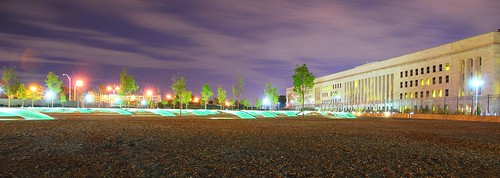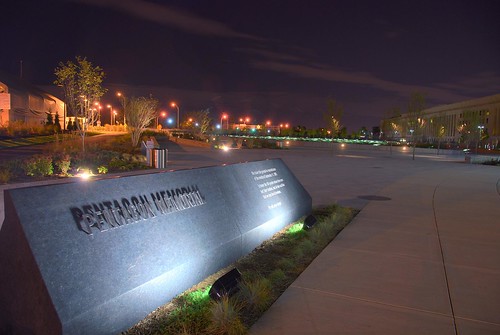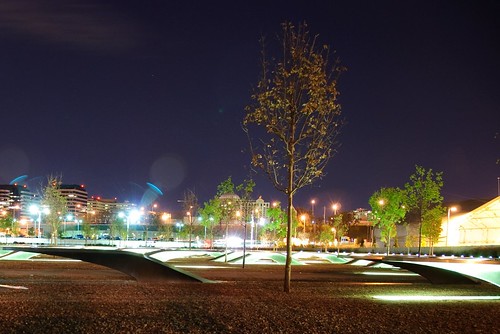You don’t need me to tell you about the history of this memorial. If you’re old enough to read this then you have some memories of the day that necessitated it. I don’t know that this town has ever put up a site paying homage to lives lost so recently; the opening ceremony was just last month, 7 years to the day after American Airlines flight 77 slammed into the side of the Pentagon. The same side where this park sits.
Nothing unusual about that; a short drive out into Virginia on 66 will take you to locations where pivotal battles in our history occurred. What is unusual is that at the Pentagon, business goes on just as it did on September 10th, 2001. Except now the world’s largest office building – where picture taking is banned even in the parking lot – now has a tourist attraction on its grounds.
Going there, you get the clear feeling that they’re not sure how to deal with that fact.
I’ve been to the memorial twice now, and I still have no idea where you’d park if you wanted to drive there. It’s entirely possible that the answer is “you don’t,” a conclusion the Pentagon’s general website about tours would seem to support. The website for the memorial is no help on that matter or, really, any other. It still speaks of when the memorial will open, rather than when it did, and provides no guidance on getting there.
If you’re one of the us who are close enough to bicycle there they’ve provided some racks to lock up to, though being 20 feet from a guard shack you wonder what thief would be discouraged by a padlock but not an M-16. More likely you’ll come in on the metro, which presents its own questions. Primarily “where the hell do I go?”
Signage is slim, but getting there is fairly simple. When you come up from the Pentagon metro stop you’re on the south-east side of the building and you need to be two faces away, on the west side. Go right – you’ll see one or two vague streetsign-sized markers – and walk around the building. The sidewalks are a little inconsistent and it feels odd to be wandering amongst the cars, but you’ll get there. Some stairs leading up to walkways can be a bit misleading but you don’t need to go up or down at all, just take the half-mile stroll around on the intermitent sidewalks.
The memorial itself is an amazing effort to impose structure on top of the chaos of random death. The wall along the outer perimeter rises in height corresponding with the ages of those who lost their lives, and has evenly spaced markers on it indicating the birth years of the dead. The latest year is 1998, the youngest victim. At the other end of the wall the last year is 1930. Years like 1979 and 1940 have empty spaces on the wall, marked only by the thin lines that border the columns. It makes for a stark experience as you come in. Those few benches for 1998, 1992, and 1990 are right there at the front. Then a long and wide section of empty ground separates them from where they resume in the line for 1979.
From any of those year markers on the wall you can look inwards and see the benches, each representing one of those who lost their lives there. If they were in the Pentagon the end of the bench faces you, their name inscribed on the end, the building where they lost their lives visible in the distance. The benches for those on United 77 face with their edges pointing towards the wall of the Pentagon. Some of these have other names etched on the underwater surface of the gurgling illuminated pools.
Both of my visits so far have been at twilight at the earliest, and I’m not sure why anyone would come any other time, given the beauty of the dim lighting coming solely from the pools and weak lights on the low wall. There seems to be no opening or closing time – I left last night after 10:30 – so your only apparent limitation is on when the Metro runs, if that’s how you come and go. Presumably you could walk over from Pentagon Row at any time.
I’m curious to see how this memorial ages, what with its off the beaten path location and apparently maintenance-heavy requirements. When I visited in the first week there were a dozens of other visitors walking around, saying little but making their presence known by the constant crunching of the loose stone underfoot. Many benches had poems or pictures sitting on their end. Most of them were unsecured against the wind, though a few were weighted down with a few bits of gravel, which when I first saw them at a distance made me think they’d been put there by jewish family members.
There were no little bits there last night, however. I saw just four other people, although that might be because of the lateness of the hour. All the benches were clear of notes and half a dozen had gone dark, like the one below.





